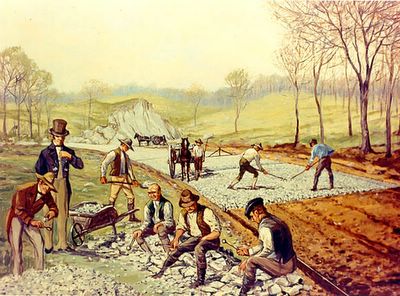
The first macadam surface in the United States was laid on the "Boonsborough Turnpike Road" between Hagerstown and Boonsboro, Maryland. By 1822, this section was the last unimproved gap in the great road leading from Baltimore on the Chesapeake Bay to Wheeling on the Ohio River. Stagecoaches using the road in winter needed 5 to 7 hours of travel to cover 10 miles.
Construction specifications for the turnpike road incorporated those set forth by John Loudon McAdam of Scotland. After side ditches were dug, large rocks were picked and raked, then were broken "so as not to exceed 6 ounces in weight or to pass a two-inch ring." Compacting work for each of the three layers was quickened using a cast-iron roller, instead of allowing for compacting under traffic.
In 1830, after 5 years of work, the 73-mile National Pike (or Cumberland Road) became the second American road to be built on the "McAdam principle."
Link




<< Home